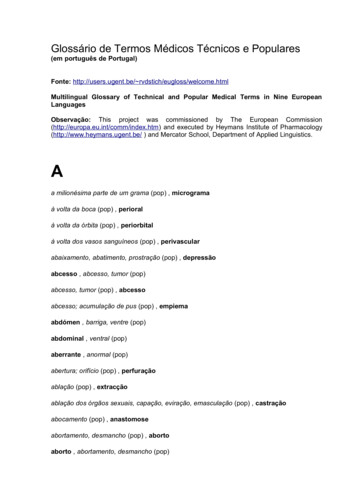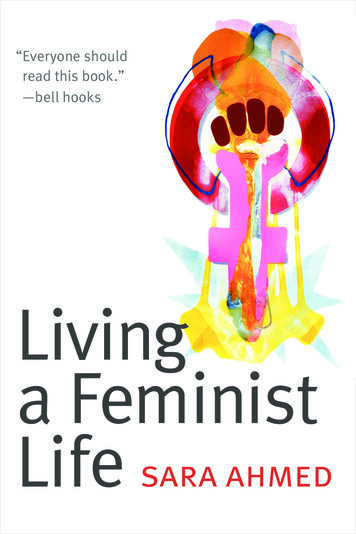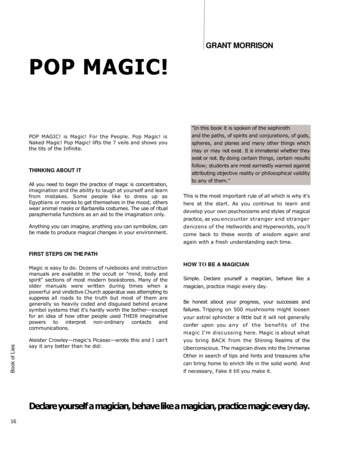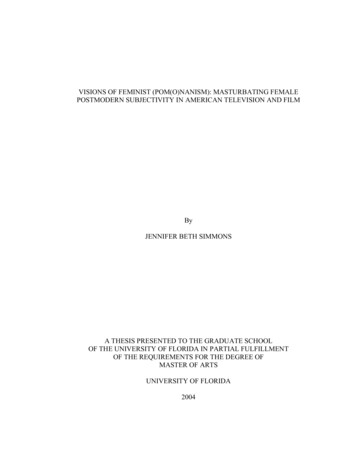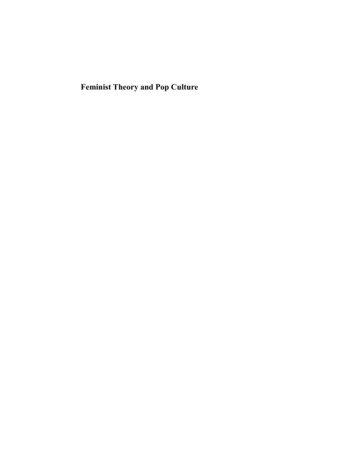
Transcription
Feminist Theory and Pop Culture
Teaching GenderVolume 5Series EditorPatricia LeavyUSAScopeTeaching Gender publishes monographs, anthologies and reference booksthat deal centrally with gender and/or sexuality. The books are intended to beused in undergraduate and graduate classes across the disciplines. The seriesaims to promote social justice with an emphasis on feminist, multiculturaland critical perspectives.Please email queries to the series editor at pleavy7@aol.comInternational Editorial BoardTony E. Adams, Northeastern Illinois University, USAPaula Banerjee, University of Calcutta, IndiaNitza Berkovitch, Ben Gurion University, IsraelRobin Boylorn, University of Alabama, USAMáiréad Dunne, University of Sussex, UKMary Holmes, University of Edinburgh, United KingdomLaurel Richardson, Ohio State University, Emerita, USASophie Tamas, Carleton University, Ottawa, Canada
Feminist Theory and Pop CultureEdited byAdrienne Trier-BieniekValencia College, Orlando, USA
A C.I.P. record for this book is available from the Library of Congress.ISBN: 978-94-6300-059-8 (paperback)ISBN: 978-94-6300-060-4 (hardback)ISBN: 978-94-6300-061-1 (e-book)Published by: Sense Publishers,P.O. Box 21858,3001 AW Rotterdam,The Netherlandshttps://www.sensepublishers.com/Printed on acid-free paperAll Rights Reserved 2015 Sense PublishersNo part of this work may be reproduced, stored in a retrieval system, or transmittedin any form or by any means, electronic, mechanical, photocopying, microfilming,recording or otherwise, without written permission from the Publisher, with theexception of any material supplied specifically for the purpose of being entered andexecuted on a computer system, for exclusive use by the purchaser of the work.
ADVANCE PRAISE FORFEMINIST THEORY AND POP CULTURE“This excellent anthology grounds feminism as articulated through four waves andfeatures feminists responding to pop culture, while recognizing that popular culturehas responded in complicated ways to feminisms. Contributors proffer lucid andengaging critiques of topics ranging from belly dancing through Fifty Shadesof Grey, Scandal and Orange is the New Black. This book is a good read as wellas an excellent text to enliven and inform in the classroom.” Jane Caputi, Ph.D.,Professor of Women, Gender and Sexuality Studies and Communication &Multimedia at Florida Atlantic University“Feminist Theory and Pop Culture is destined to be as popular as the culture itcritiques. The text plays up the paradoxes of contemporary feminism and requiresits readers to ask difficult questions about how and why the popular bring uspleasure. It is a contemporary collection that captures this moment in feminist timewith diverse analyses of women’s representations across an impressive swath ofpopular culture. Feminist Theory and Pop Culture is the kind of text that makes mewant to redesign my pop culture course. Again.” Ebony A. Utley, Ph.D., AssistantProfessor of Communication at California State University-Long Beach, author ofRap and Religion.“As a woman who tries to bring a feminist perspective to conversations with peoplewho might never have considered how feminist histories and theories affect them,I have been waiting for a collection like this!” Emily Lindin, Founder of TheUnSlut Project, author of UnSlut: A Diary and a Memoir, and creator of “Slut: ADocumentary Film.”“Feminist Theory and Pop Culture offers some excellent material for undergraduateteaching. I’m especially excited by the contemporary and highly relevant analyses ofOlivia Pope from Scandal (Griffin) and the newly fashionable return of belly dancing(Moe). By providing readers with concrete and familiar examples from popularculture media and practices, Trier-Bieniek’s collection facilitates students’ grasp oftheoretical materials. Feminist analysis of Black stereotypes acquire an urgency andclarity for undergraduates when linked to and explicated through Scandal, one of thefew shows a majority of my students watch. Likewise, Moe’s arguments about themale gaze in belly dance provide leverage for discussions of contemporary hypersexualization as expressed through practices such as middle-class pole classes andadolescent girls’ clothing extremes. The chapters provide a wide range of specificcontexts and are highly engaging for classes on culture, pop culture, gender, feministtheory and representation.” Sarah M. Corse, Ph.D. Associate Professor of Sociologyat the University of Virginia.
For the Trier side: Mom, Dad, Becky, Uncle Rod and Aunt Casi.This one’s for you. And for Dolores Bieniek, I adore you.
TABLE OF CONTENTSAcknowledgments xiIntroductionAdrienne Trier-Bieniek xiii1. Unveiling the Gaze Angela M. Moe12. Girls, Grrrls, Girls April Kalogeropoulos Householder193. Olivia Pope as Problematic and Paradoxical Rachel Alicia Griffin354. The “Un-Quiet Queen” Melvin L. Williams and Tia C.M. Tyree495. Queerness (Un)shackled Lauren J. DeCarvalho and Nicole B. Cox656. Warning! Social Construction Zone Carrie L. Buist and Jean-Anne Sutherland777. Girl Rising and the Problematic Other Emily Bent898. Paradoxes of Postfeminism Patricia R. Boyd1039. From Street to Tweet Jenn Brandt and Sam Kizer115About the Contributors 129About the Editor 133ix
ACKNOWLEDGMENTSThank you to Sense Publishers, particularly to Peter de Liefde for supporting thisproject and to Patricia Leavy for creating and supporting the Teaching Genderseries. Thank you to Paul Chambers for your marketing efforts and the entire SensePublishers team. Thank you to every contributor for sharing their expertise andtalent. It is truly an honor to have you be a part of this work and to have you as acolleague.Many thanks to Angie Moe, the greatest dissertation chair in the world. I alsothank the trio of mentors who introduced me to the theory and action of feministtheory, my ladies from Grand Valley State University who are Judy Whipps,Kathleen Underwood and Marlene Kowalski-Braun. Each of you are so specialto me and your knowledge and scholarship is evident in both the introduction andconception of this book. Thank you for teaching me. I also acknowledge the usualsuspects in my life, my soul-sister’s Efua Akoma and Beatrice Yarbrough and theirfamilies, Lee Paulsen and family, The Clapper Twins, Andy and Dan, and theirfamilies, the Sperti’s, the Trier’s, the Bieniek’s, Chastity Orrship, Catherine Kelly,Bethany Kelly, Vadzim Sheikra, Dylan The Poodle and Grace Kelly The Dog, myfriend and colleague Melissa Sierra and my big-little sister Jen Wiles. Thanks to myfour-legged pals Mara and Charlie for the constant company and to my two-leggedHusband Tim Bieniek who has been my awesome partner in crime since 1997. Youmake my heart happy. Finally, thanks to Rick and Deanne Trier, you raised me right.xi
ADRIENNE TRIER-BIENIEKINTRODUCTIONThe problem with gender is that it prescribes how we should be rather thanrecognizing how we are. Chimamanda Ngozi AdichieWhat bothers me the most is that people say Hillary is a bitch. You know what?Bitches get stuff done. Tina Fey (on Hillary Clinton)During this book’s conception, writing and publication there have been an onset ofpositive indications that feminism is alive and well in popular culture. Televisionseries such as The Good Wife, Parks and Recreation, Scandal, Orange is the NewBlack, 30 Rock, The Mindy Project and Transparent have given viewers exposureto smart, funny and diverse female characters. By standing in front of a massivesign reading “Feminist” while performing at the 2014 Mtv Video Music Awards,Beyoncé gained the praise of many feminist scholars. A statement that, as AmandaMorcotte from Slate notes, in an image-driven culture where the five second soundbite rules and meme’s are more popular than books, the image of Beyoncé declaringher feminism to the world just felt amazing.What may have had the largest feminist impact on popular culture in recentmemory comes from Disney. In 2013, with the release of the film Frozen, Disneymarketed a typical princess story. The trailer for the film revolved around a talkingsnowman, singing and dancing characters and images of two princesses. Yet, whatthe marketing of the film didn’t show, was that the story was really an exercisein the feminist standpoint, or presenting women’s stories from their own points ofview. Based on the children’s story, The Snow Queen, Frozen is a tale of two sisters,Anna and Elsa. Elsa is born with the magic power to create snow and ice. On Elsa’scoronation day, she accidentally freezes the fictional Kingdom of Arendelle and,out of the fear that her powers have been discovered, flees to the Nordic mountains.The film then focuses on Elsa’s journey of self-discovery and Anna’s quest to returnher sister to Arendelle, unfreeze the land and re-build their relationship. While thereare magical trolls which talk of “an act of true love” and two potential love interestsfor Anna, the crux of the story comes at the end when the “act of true love” whichwill save Anna’s life is the love between sisters. The impact of the film, particularlyon young girls, has been phenomenal. Disney has reported families waiting inxiii
INTRODUCTIONline for upwards of three hours to “meet” Anna and Elsa in the Magic Kingdom.Merchandise based on the film has been flying off shelves resulting in stores withinDisney World limiting the amount of Frozen products each person can purchase andmovie theatres began hosting Frozen sing-a-long screenings. This overwhelmingacceptance of the film could be attributed to girls and women finding a story whichseemingly honored the experience of having a sister (or close female friend) andprivileging that relationship above romance or love-interests.The juxtaposition of feminist theory and popular culture has an inevitable impacton the consumption of culture mainly because popular culture has the power to putup a mirror to our lives and show connections between media, socialization andidentity. Pop culture is generally the images, narratives and ideas that circulate widelyin contemporary culture. What makes something “popular” is its general availabilityto the masses and, from a social science point of view, it is usually something thatwe can consume. (Trier-Bieniek and Leavy, 2014) Additionally, the impact of popculture is often subject to debate in academic communities. While some feel that themasses get a say in production of culture and the direction of media, like TheodorAdorno and Max Horkheimer find that pop culture works to support the interestsof those in power. (Milestone and Meyer, 2011) This text is largely situated in thelatter, particularly when we consider the definition of feminism as a movementfocused on the political and economic equality of the sexes. Pop culture’s tendencyto simultaneously celebrate and neglect this concept is one of the reasons why it is soripe for exploration. To that end, an understanding of feminism becomes necessaryin order to see how inequality and gender are linked in culture.THE WAVES OF FEMINISM AS A HISTORY OF FEMINIST THEORYEssentially, feminist theory is associated with women’s inequality and subordination.However, as you will see in these pages and in the history of feminism, as culturehas developed and changed so has feminist theory. It is not surprising to seefeminist theory linked with concepts like queer theory (aimed at gender identityin heteronormative societies) or theories related to women of color which areoften based in how race and ethnicity shape experiences. Additionally, theoriesof masculinity, such as C.J. Pascoe’s 2007 book Dude You’re a Fag: Masculinityand Sexuality in High Schools, posit that there are many different approaches tomasculinity and that men simultaneously benefit and suffer from patriarchalculture. Regardless, each incarnation has roots in similar parts of history. As bellhooks writes “Before women’s studies classes, before feminist literature, individualwomen learned about feminism in groups. The women in the groups were the first tobegin to create feminist theory which included both an analysis of sexism, strategiesfor challenging patriarchy, and new models of social interaction.” (2000, p. 19)Congregating in groups to talk about feminist theory was also how activism andconsciousness raising became synonymous with feminism. Consciousness raising,or raising awareness of a topic/idea/revolution in order to get a better understanding,xiv
INTRODUCTIONis often the link between theory and activism. This is why feminist theory andfeminist activism often work in tandem.Additionally, defining feminism has become especially difficult in contemporarysociety as many women now arrive at adulthood having gone their entire livesbenefiting from feminist movements and scholarship. When asked “Who is afeminist?”, responses will probably vary depending on how one conceptualizesthe term. However, most people will say that there are characteristics of feminists,founded in personal politics or the need to dismantle patriarchal structures, whichare indicators of feminist identity. Understanding how feminism came to be is key tounderstanding where it is going and how it is received by diverse groups of women.Feminism is defined as happening in “waves.” Just like a literal wave, as onewave moves out another comes in but still retains much of the structure of theoriginal wave. As such, feminist movements are characterized as first, second andthird waves respectively, with recent discussions happening regarding what makesa fourth wave. Perhaps the intention behind the wave analogy was a demonstrationthat women have not yet received the equal rights and the women’s movement is anongoing process. If this was the case, the analogy for the waves of feminism can alsoact as a perfect illustration for the generations of women who make it up.Historically, the work of Mary Wollstonecraft is often cited as the beginning ofthe first wave of feminism as it is one of the first writings which discuss women’sliberation. In her 1792 essay, A Vindication of the Rights of Women, she writes “Imay be accused of arrogance; still I must declare what I firmly believe, that allthe writers who have written on the subject of female education and manners fromRousseau to Dr. Gregory, have contrived to render women more artificial, weakcharacters, then they would otherwise have been; and, consequently, more uselessmembers of society” (1986:7). Wollstonecraft began a discussion of women’s placein society, a conversation which evolved into the Seneca Falls Convention of 1848.The Seneca Falls Convention produced the Declaration of Sentiments. Basedon the Declaration of Independence, the Declaration of Sentiments was primarilyauthored by Elizabeth Cady Stanton. In part it reads “The history of mankind isa history of repeated injuries and usurpations on the part of man toward woman,having in direct object the establishment of an absolute tyranny over her.” (2000, p.64) The purpose of this declaration was to establish a list of ways women have beendeprived of rights and ends with resolutions, mainly contending that women mustreceive the right to vote. It was with this declaration that the first plans were madefor suffrage and the convention lead to the work of suffragette women like SusanB. Anthony, Elizabeth Cady Stanton and eventually Alice Paul and Lucy Burns andending with the 19th amendment.While for most this period of feminist history is marked with women fighting forthe right to vote, simultaneously there were rumblings of freedom for the enslaved.Perhaps the most noted women who had a hand in both movements was theAfrican-American abolitionist Sorjourner Truth, a former slave and the first womenof color to successfully sue a white slave-owner to reclaim the child he owned.xv
INTRODUCTIONTruth’s famous speech “Ain’t I a Woman?” an extemporaneous speech given to theWomen’s Convention in Akron, Ohio in 1951, was a response to men in the audiencediscussing how women are delicate and should be treated as such. In part, Truthstated “That man over there says that women need to be helped into carriage, andlifted over ditches and to have the best place everywhere. Nobody ever helps me intocarriages or over mud-puddles, or gives me any best place! And ain’t I a woman?”(2000, p. 66) She goes on to respond to a man who asserted that women cannot havethe same rights as men because Jesus Christ was a man. Truth states, “Where didyour Christ come from? From God and a woman! Man had nothing to do with Him.”(2000, p. 66) Truth’s legacy is indefinitely linked with the foundation of feministtheory because it relates the activism of women of color to the role they often playedin being on society’s margins, something that became a focus of later waves offeminism. Many years later, Kerry Washington, an American actress, would performthis speech as part of Voices of People’s History of the United States gathering.Some notable works and events to emerge from the first wave: The book Women in the Nineteenth Century by Margaret Fuller in 1845. Married Women’s Property Act-first passed in New York 1839, extending rightsof property and to earn a salary. Oberlin College, the first American co-educational college/university, wasfounded in 1833. First birth control clinic was founded in Brooklyn, New York in 1916 and PlannedParenthood was incarnated as the American Birth Control League in 1938. (Itwould become Planned Parenthood in 1942.)Some notable works and events in first wave pop culture: The 2004 film Iron Jawed Angels depicts suffragette Alice Paul’s crusade in theten years before women were awarded the right to vote. Alice Paul is played byAcademy Award winner Hilary Swank. Mary Shelly publishes the novel Frankenstein in 1818, first anonymously and thenunder Shelly’s name in 1823. Shelly, is also the daughter of Mary Wollstonecraftand Frankenstein contains many references to her mother’s writing and ideas. Jane Austin publishes multiple stories centered on female characters and theirresistance to depend on men. Charlotte Perkins Gilman publishes The Yellow Wallpaper in 1892, address thelack of attention paid to women’s physical and mental well-being. Hattie McDaniel becomes the first African-American to win an Academy Awardfor her portrayal of Mammy in Gone with the Wind in 1939.Feminism’s second wave is characterized by the women’s rights movements ofthe 1960s and 1970s with the mantra “The Personal is Political.” This wave becamefocused on women pursuing careers, reproductive rights, addressing violenceagainst women and pay equality (to name a few) as well as a focus on laws like theEqual Rights Amendment. Spurred by Betty Friedan’s 1963 book, The Femininexvi
INTRODUCTIONMystique, many women of this time read about and related to the “problem whichhas no name.” A graduate of Smith College, with a degree in psychology, Friedanwas dismissed from her journalism job in 1952 because she was pregnant with hersecond child. While she was a stay-at-home mom Friedan began to question whywomen were shelving their education in order to raise families. In 1957 she surveyedwomen at her college reunion, asking about their education and satisfaction withlife. What she found was that, while women were more likely than their mothers toattend college, they were also shelving their careers to stay at home and, as a result,felt under stimulated, constantly asking the question “Is this all?” Seemingly thesewomen had everything, but found themselves intellectually unfilled, wanting careersand feeling guilty for not being thankful for their lives.One of the main theoretical frameworks which characterized the second waveof feminism is Simone de Beauvoir’s book The Second Sex in which de Beauvoirdeclares that women are categorized as the Other. She writes, “The category of theOther is as primordial as consciousness itself. In the most primitive societies, inthe most ancient mythologies, one finds the expression of a duality-that is of theSelf and Other” (1948, p. xxii). Simone de Beauvoir writes of women’s position insociety as secondary, almost as an afterthought and, as a result, women involuntarilyparticipate in oppressive social norms. She writes, “Why is it that women do notdispute male sovereignty? No subject will readily volunteer to become the object, theinessential ” (1948, p. xxiv). What makes this work central to the second wave offeminism is Simone de Beauvoir’s contention women stay in a subordinate positionbecause they have been made to feel complacent. The work of women like Friedanand de Beauvoir, combined with the changing political climate of the 1960s, createda sense of urgency for feminists to develop a second generation of women who werewilling to carry on, and expand upon the work of previous generations of women.Commonly referred to as “women’s lib”, the second wave took on many areas ofwomen’s rights, particularly violence against women, prostitution and pornography,birth control and access to contraception and the growing need for more women inthe work force and in political office.However, criticism of the second wave has focused on its contradictions,particularly relating to race and social class. Women of color have reported feelinglike they were placed on the margins of the waves of feminism in general and thesecond wave of feminism in particular. Kinser writes, “Second-wave feminism mayhave been better at making decisions about what was in the purview of feminism,but it may have silenced voices that should have been part of the feminist dialogue”(2004, p.145).Perhaps it is best to start with bell hooks’s critique of Betty Friedan. hook’s work,particularly her essay’s on feminist theory in Feminist Theory: From Margin toCenter which discusses the marginalized experiences women of color have withfeminism. hooks writes, “Betty Friedan’s The Feminine Mystique is still heralded ashaving paved the way for contemporary feminist movement-it was written as if thesewomen did not exist (It) actually referred to the plight of a select group of collegexvii
INTRODUCTIONeducated, middle and upper class, married white women-housewives bored withleisure, with the home, with children ” (1984, p. 1). hooks, and many women ofcolor theorists, found much fault with the work of Friedan whose pool of interviews,friends and neighbor’s she knew, were (for the most part) white, middle class womenliving in homes in nice neighborhoods. The assertion that these women wanted tostep away from their homes and work was almost offensive to hooks because, as shecontended, women of color have always worked. “She did not discuss who wouldbe called in to take care of the children and maintain the home if more women likeherself were freed from their house labor ” (1984, p. 1) Whether it be in the fields,or as a caregiver to white women’s children (see Ehrenreich and Hoschild, 2003), oron the front lines of equality battles women of color were present in the work world,mainly because the choice to stay at home and raise children was something that,hooks argues, was left to white, upper class women.Patricia Hill Collins 1990 book, Black Feminist Thought, while not specificallysituated in the second wave but certainly influenced by it, addressed the need toplace the voices and experiences of women of color at the forefront of feministtheory. Black Feminist Thought became situatied in critical social theory as it wasborn out of a critique of oppression and aimed to find ways to survive in economicinjustice. Hill Collins argues that, particularly for African-American women, criticalsocial theory is about bodies of knowledge and industrial practices that strugglewith questions facing Black women. Black Feminist Thought catapulted questionsof contradictions between dominant ideologies and their devalued status. Topics likethe merit of “good” mothering being based on stay-at-home motherhood, a standardrooted in race and class, became part of discussions of feminism. Hill Collinsconnected these scenarios to being “the outsider looking in”, defining Black FeministThought as a metaphorical margin, a place where Black women could see the worldthey are supposed to exist in but could not quite participate. The experiences ofwomen of color produce their own category of knowledge which can be used toadvance understanding of what it is like to be a marginalized group within an alreadymarginalized group.Gloria Anzaldua’s contribution to feminist theory rested in the U.S. borderlandsas physical and metaphorical boundaries faced by women of color. She uses theexamples of human trafficking to illustrate Mexican women being used as monetarygain. “The Mexican women is especially at risk. Often the coyote doesn’t feed her fordays or let her go to the bathroom. Often he rapes her or sells her into prostitution”(1987:34). Additionally, Audre Lorde’s 1984 book Sister Outsider: Essays andSpeeches chronicled her journey to discover her sexuality through the lens ofidentifying as a Black feminist poet. Lorde contends that the feminist movement,which had largely been comprised of white women, ignored the aspects of race andclass present in the struggle for women’s rights. She also contend that Black andThird World people, people who are the working poor and who are elderly took onthe role of the “dehumanized inferior.” She questioned why it must be that membersof oppressed groups should be the ones reaching out to educate White America.xviii
INTRODUCTIONEssentially, writing like Lorde, Hill Collins, hooks and Anzaldua laid thegroundwork for an intersectional approach to future discussions in feminist theory.Intersectionality, as it is commonly called, can be traced to the work of KimberleCrenshaw but may have deeper roots in a statement by the Combahee River Collective(CRC) who wrote A Black Feminist Statement in 1977. Crenshaw’s contention is thatforms of oppression are connected, as the CRC said, they are interlocking. Thus, itbecomes difficult to address oppression simply based on one category of oppression(i.e. race, gender, social class, sexuality etc.) This theory argues that examining theoppression of women cannot happen in a vacuum, rather we must be examining thewhole of women’s experiences using their standpoint.Some notable works and events to emerge from the second wave: Mass production of oral contraceptives. Equal Pay Act of 1963, Civil Rights Act of 1964, Title IX is passed in 1972 andRoe vs. Wade is passed in 1973. Additionally, Laws passed against marital rape,limiting access to contraception and repealing “help wanted” ads which werearranged by sex. Creation of the National Organization of Women (Originally headed by BettyFriedan) in 1966. The Redstockings Group, who will later publish the radical feminist work, TheRedstockings Manifesto is formed in 1969. Sexual Politics by Kate Millett is published in 1970, critiquing sexual theoryposited by researchers such as Sigmond Freud and John Stuart Mill. Against Our Will: Men, Women and Rape is published in 1975 by SusanBrownmiller. The book is one of the first to address rape myths in contemporarysociety. Laura Mulvey publishes Visual Pleasure and Narrative Cinema in 1972,addressing the male gaze and its prevalence in film.Some notable works and events in second wave pop culture: Gloria Steinem and Letty Cottin Pogrebin founded Ms. Magazine in 1972. Tennis player Billie Jean King defeats Bobby Riggs in the televised “Battle of theSexes” in 1973. The Mary Tyler Moore show premieres in 1970, depicting the single woman asindependent, career driven and politically aware. The television show Maude becomes one of the first to address abortion as a storyline.Many feminist writers relate the beginning of the third wave of feminism to 1991and the work of Naomi Wolf who, in The Beauty Myth, stated that feminism neededa rekindling. Others point to a statement made by Rebecca Walker in Ms. Magazinein 1992. Walker, infuriated by the Clarence Thomas hearings and the implicationsthey had for minority women, declared that “I am not a post-feminism feminist, I amthe Third Wave” (Walker, 1992 p. 41).xix
INTRODUCTIONAmy Richards and Jennifer Baumgardner, via their 2000 book Manifesta: YoungWomen, Feminism and the Future are also credited with bringing the third waveof feminism into the forefront. In Manifesta they argue that feminist and politicaltheory has as much a place in third wave feminism as the impact of pop culture.Third wave’s use of activism via pop culture was particularly evident in much of themusic in the early to mid 1990s, especially with the Riot Grrrl movement. The RiotGrrrl music scene was a grouping of bands which started in the Washington D.C. areain the early 1990s as a way for young women to participate in the male-dominatedpunk rock scene. (Trier-Bieniek, 2013) The “Riot Grrrl” title was conceptualized as away to “[r]eclaim the validity and power of youth with an added growl to replace theperceived passitivity of ‘girl’” (Rosenberg and Garofalo, 2001, p. 810). Essentially,the combination of pop culture and feminism signified the third wave because itallowed new generations of feminist women to be who they want to be, but with apolitical consciousness.The third wave of feminism has had a broad focus as it is the first generation offeminists to grow up in the cyber age and because there has been much focus oneliminating notions of post-feminism and contentions that feminism is for whitewomen. Because current generations of women have grown up with feminismperhaps it is for this reason that the emergence of the third wave of feminism isoften confused with the “post feminist” era. “For these women, and for anyoneborn after the early 1960’s, the presence of feminism in our lives is taken forgranted. For our generation, feminism is like fluoride. We scarcely notice thatwe have it- it’s simply in the water” (Richards and Baumgardner 2000, p. 17).Because young women gro
to me and your knowledge and scholarship is evident in both the introduction and conception of this book. Thank you for teaching me. I also acknowledge the usual suspects in my life, my soul-sister’s Efua Akoma and Beatrice Yarbrough and their families, Lee Paulsen and family, Th

